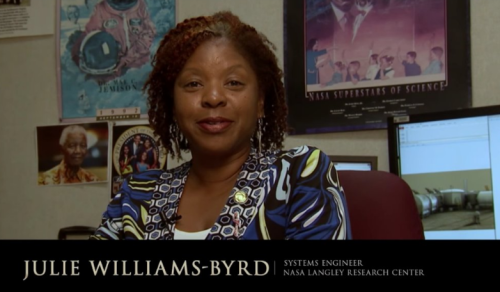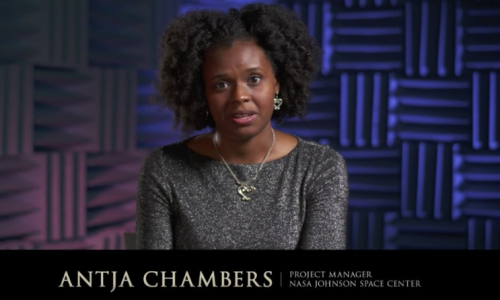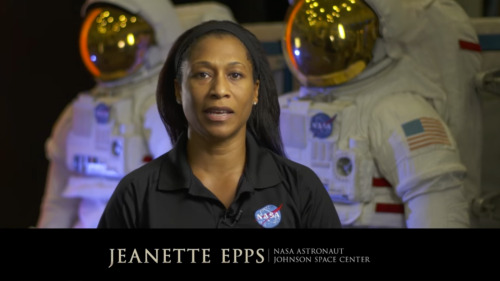A New Study Has Found Evidence That Brain Tumours Use Fat As Their Preferred Source Of Energy, Bringing

A new study has found evidence that brain tumours use fat as their preferred source of energy, bringing into question the decades-long assumption that sugar is their main fuel source.
If confirmed, this could fundamentally change the we treat cancer in the future, because until very recently, scientists have been focussing their efforts on ways to starve cancer cells of their sugar supply.
“For 60 years, we have believed all tumours rely on sugars for their energy source, and the brain relies on sugars for its energy source, so you certainly would think brain tumours would,” lead researcher Elizabeth Stoll, a neuroscientist from Newcastle University in the UK, told Ian Johnston at The Independent.
Read more…
More Posts from Contradictiontonature and Others





The film “Hidden Figures,” based on the book by Margot Lee Shetterly, focuses on the stories of Katherine Johnson (left, after receiving the Medal of Freedom in 2015), Mary Jackson and Dorothy Vaughan, African-American women who were essential to the success of early spaceflight. Today, NASA embraces their legacy and strives to include everyone who wants to participate in its ongoing exploration. “Progress is driven by questioning our assumptions and cultural assumptions,” NASA Administrator Charles Bolden says in a new video. “Embracing diversity and inclusion is how we as a nation will take the next giant leap in exploration.“
- Source
Let’s learn about today’s black heroes we all can look up to!
Organic Chemistry, Part 2/6
Reaction Mechanisms: Electrophilic addition to double bonds, SN2, SN1, E1, E2, and the decision tree







Next week: EAS, NAS, pericyclic reactions, Claisen rearrangements, and radical reactions!
Part 1

For #WorldBeeDay, here’s a look at the chemistry behind the honey some bees produce: https://ift.tt/2GV5qtq https://ift.tt/2LJpsIe

It’s a tremendous Trilobite Tuesday!
When most of us think about trilobites, we imagine rather small creatures that inhabited the ancient seas. Indeed, most members of the more than 25,000 scientifically recognized trilobite species were less that three inches in length. Occasionally, however, paleontologists encounter a megafauna where, due to a variety of circumstances, the trilobite species were huge. One of these megafaunas can be found near the small Portuguese town of Arouca where the 450 million year-old Valongo formation produces prodigious numbers of exceptionally large Ordovician-age trilobites, such as this 41 cm Hungioides bohemicus. Other trilobite magafaunas appear sporadically around the globe, including Cambrian locations in Morocco and Devonian outcrops in Nevada.
Meet many more trilobites on the Museum website.

WHAT??? Time to update those textbooks.
Did life begin on land rather than in the sea?
Stromatolites are round, multilayered mineral structures that range from the size of golf balls to weather balloons and represent the oldest evidence that there were living organisms on Earth 3.5 billion years ago.
Scientists who believed life began in the ocean thought these mineral formations had formed in shallow, salty seawater, just like living stromatolites in the World Heritage-listed area of Shark Bay, which is a two-day drive from the Pilbara.
But what Djokic discovered amid the strangling heat and blood-red rocks of the region was evidence that the stromatolites had not formed in salt water but instead in conditions more like the hot springs of Yellowstone.
The discovery pushed back the time for the emergence of microbial life on land by 580 million years and also bolstered a paradigm-shifting hypothesis laid out by UC Santa Cruz astrobiologists David Deamer and Bruce Damer: that life began, not in the sea, but on land.
Stromatolites.Credit: © Ints / Fotolia

One of the largest icebergs ever recorded, packing about a trillion tons of ice or enough to fill up two Lake Eries, has just split off from Antarctica, in a much anticipated, though not celebrated, calving event.
A section of the Larsen C ice shelf with an area of 2,240 square miles (5,800 square kilometers) finally broke away some time between July 10 and today (July 12), scientists with the U.K.-based MIDAS Project, an Antarctic research group, reported today.
Continue Reading.

It was one of the very first motion pictures ever made: a galloping mare filmed in 1878 by the British photographer Eadweard Muybridge, who was trying to learn whether horses in motion ever become truly airborne.
More than a century later, that clip has rejoined the cutting edge. It is now the first movie ever to be encoded in the DNA of a living cell, where it can be retrieved at will and multiplied indefinitely as the host divides and grows.
The advance, reported on Wednesday in the journal Nature by researchers at Harvard Medical School, is the latest and perhaps most astonishing example of the genome’s potential as a vast storage device.
Continue Reading.

Today is World Blood Donor Day – here’s a look at some blood chemistry! More info/high-res image: http://wp.me/s4aPLT-blood

Antibiotic resistance has been called one of the biggest public health threats of our time. There is a pressing need for new and novel antibiotics to combat the rise in antibiotic-resistant bacteria worldwide.
Researchers from Florida International University’s Herbert Wertheim College of Medicine are part of an international team that has discovered a new broad-spectrum antibiotic that contains arsenic. The study, published in Nature’s Communication Biology, is a collaboration between Barry P. Rosen, Masafumi Yoshinaga, Venkadesh Sarkarai Nadar and others from the Department of Cellular Biology and Pharmacology, and Satoru Ishikawa and Masato Kuramata from the Institute for Agro-Environmental Sciences, NARO in Japan.
“The antibiotic, arsinothricin or AST, is a natural product made by soil bacteria and is effective against many types of bacteria, which is what broad-spectrum means,” said Rosen, co-senior author of the study published in the Nature journal, Communications Biology. “Arsinothricin is the first and only known natural arsenic-containing antibiotic, and we have great hopes for it.”
Although it contains arsenic, researchers say they tested AST toxicity on human blood cells and reported that “it doesn’t kill human cells in tissue culture.”
Continue Reading.
-
 scentlessapprenticeship liked this · 6 years ago
scentlessapprenticeship liked this · 6 years ago -
 dubiousspectrum reblogged this · 6 years ago
dubiousspectrum reblogged this · 6 years ago -
 sapony01 liked this · 8 years ago
sapony01 liked this · 8 years ago -
 bum-arse liked this · 8 years ago
bum-arse liked this · 8 years ago -
 whatslifehonestly liked this · 8 years ago
whatslifehonestly liked this · 8 years ago -
 elvinbiologist reblogged this · 8 years ago
elvinbiologist reblogged this · 8 years ago -
 auaalv reblogged this · 8 years ago
auaalv reblogged this · 8 years ago -
 auaalv liked this · 8 years ago
auaalv liked this · 8 years ago -
 false-senpai liked this · 8 years ago
false-senpai liked this · 8 years ago -
 sunnysarasmiles liked this · 8 years ago
sunnysarasmiles liked this · 8 years ago -
 heardthemermaidssinging reblogged this · 8 years ago
heardthemermaidssinging reblogged this · 8 years ago -
 imsurroundedbyidiots553 reblogged this · 8 years ago
imsurroundedbyidiots553 reblogged this · 8 years ago -
 zenya liked this · 8 years ago
zenya liked this · 8 years ago -
 health-and-science-things reblogged this · 8 years ago
health-and-science-things reblogged this · 8 years ago -
 genderisjendar reblogged this · 8 years ago
genderisjendar reblogged this · 8 years ago -
 genderisjendar liked this · 8 years ago
genderisjendar liked this · 8 years ago -
 tiberiusmulder reblogged this · 8 years ago
tiberiusmulder reblogged this · 8 years ago -
 scifigamingmom reblogged this · 8 years ago
scifigamingmom reblogged this · 8 years ago -
 lilith--marie-blog liked this · 8 years ago
lilith--marie-blog liked this · 8 years ago -
 complacentdevil liked this · 8 years ago
complacentdevil liked this · 8 years ago -
 jasoncanty01 reblogged this · 8 years ago
jasoncanty01 reblogged this · 8 years ago -
 starsaremymuse reblogged this · 8 years ago
starsaremymuse reblogged this · 8 years ago -
 fuckthesharks reblogged this · 8 years ago
fuckthesharks reblogged this · 8 years ago -
 cinnamoncountess liked this · 8 years ago
cinnamoncountess liked this · 8 years ago -
 kimmicakes13 reblogged this · 8 years ago
kimmicakes13 reblogged this · 8 years ago -
 bronzedawn liked this · 8 years ago
bronzedawn liked this · 8 years ago -
 angel-with-a-pipette reblogged this · 8 years ago
angel-with-a-pipette reblogged this · 8 years ago -
 vilesssserpent liked this · 8 years ago
vilesssserpent liked this · 8 years ago -
 tcgasclepius-blog reblogged this · 8 years ago
tcgasclepius-blog reblogged this · 8 years ago -
 secretporcupine reblogged this · 8 years ago
secretporcupine reblogged this · 8 years ago -
 biopiro liked this · 8 years ago
biopiro liked this · 8 years ago -
 boliaogy reblogged this · 8 years ago
boliaogy reblogged this · 8 years ago -
 jeekoness liked this · 8 years ago
jeekoness liked this · 8 years ago -
 cobaltgear liked this · 8 years ago
cobaltgear liked this · 8 years ago -
 shinyhappygoth liked this · 8 years ago
shinyhappygoth liked this · 8 years ago
A pharmacist and a little science sideblog. "Knowledge belongs to humanity, and is the torch which illuminates the world." - Louis Pasteur
215 posts
